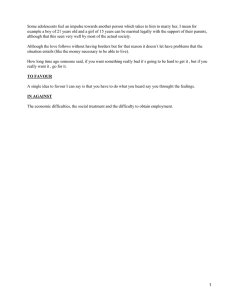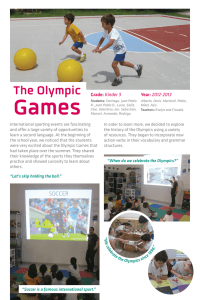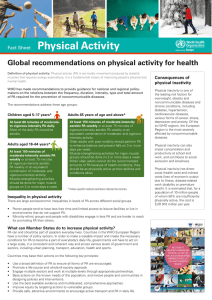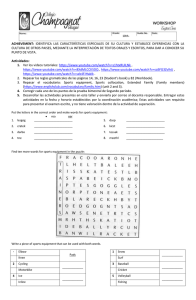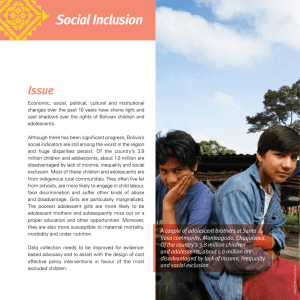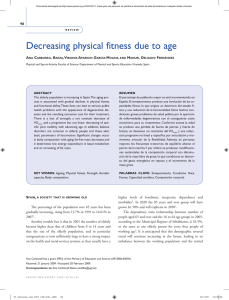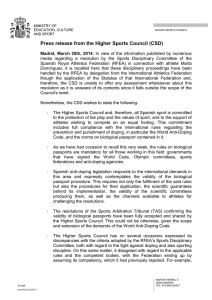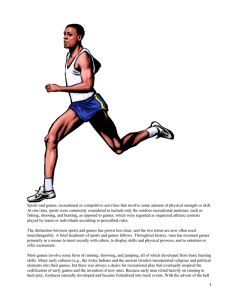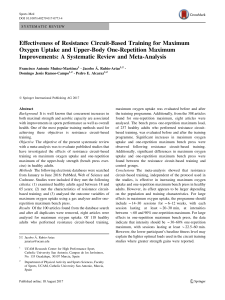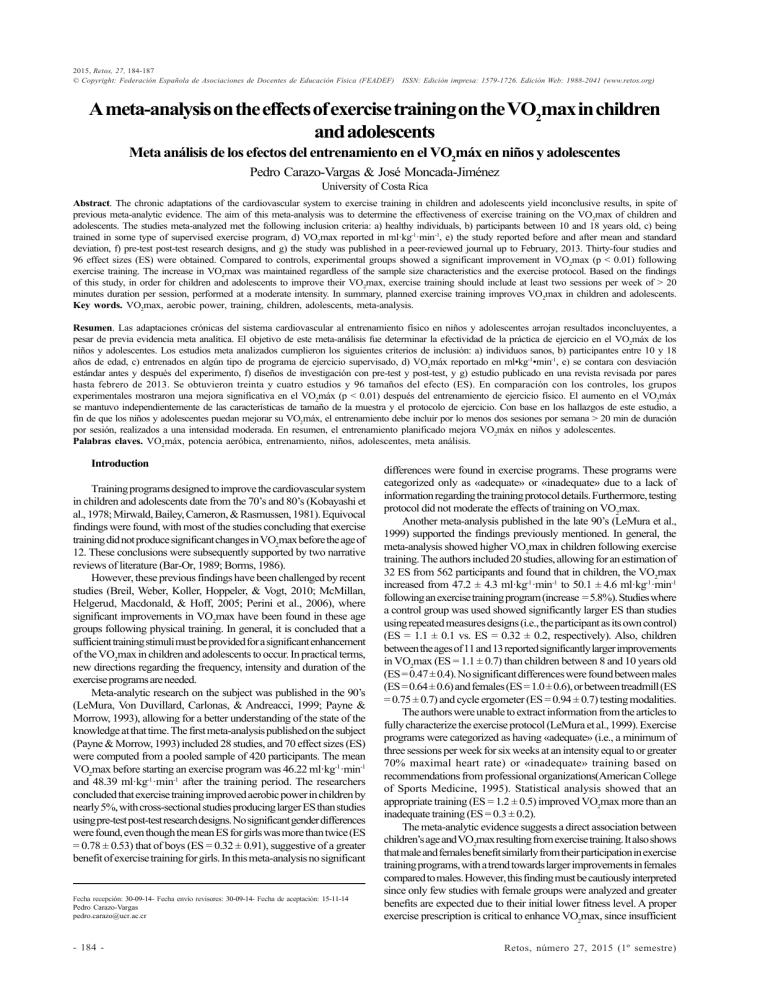
2015, Retos, 27, 184-187 © Copyright: Federación Española de Asociaciones de Docentes de Educación Física (FEADEF) ISSN: Edición impresa: 1579-1726. Edición Web: 1988-2041 (www.retos.org) A meta-analysis on the effects of exercise training on the VO2max in children and adolescents Meta análisis de los efectos del entrenamiento en el VO2máx en niños y adolescentes Pedro Carazo-Vargas & José Moncada-Jiménez University of Costa Rica Abstract. The chronic adaptations of the cardiovascular system to exercise training in children and adolescents yield inconclusive results, in spite of previous meta-analytic evidence. The aim of this meta-analysis was to determine the effectiveness of exercise training on the VO2max of children and adolescents. The studies meta-analyzed met the following inclusion criteria: a) healthy individuals, b) participants between 10 and 18 years old, c) being trained in some type of supervised exercise program, d) VO2max reported in ml·kg-1·min-1, e) the study reported before and after mean and standard deviation, f) pre-test post-test research designs, and g) the study was published in a peer-reviewed journal up to February, 2013. Thirty-four studies and 96 effect sizes (ES) were obtained. Compared to controls, experimental groups showed a significant improvement in VO2max (p < 0.01) following exercise training. The increase in VO2max was maintained regardless of the sample size characteristics and the exercise protocol. Based on the findings of this study, in order for children and adolescents to improve their VO2max, exercise training should include at least two sessions per week of > 20 minutes duration per session, performed at a moderate intensity. In summary, planned exercise training improves VO2max in children and adolescents. Key words. VO2max, aerobic power, training, children, adolescents, meta-analysis. Resumen. Las adaptaciones crónicas del sistema cardiovascular al entrenamiento físico en niños y adolescentes arrojan resultados inconcluyentes, a pesar de previa evidencia meta analítica. El objetivo de este meta-análisis fue determinar la efectividad de la práctica de ejercicio en el VO2máx de los niños y adolescentes. Los estudios meta analizados cumplieron los siguientes criterios de inclusión: a) individuos sanos, b) participantes entre 10 y 18 años de edad, c) entrenados en algún tipo de programa de ejercicio supervisado, d) VO2máx reportado en ml•kg-1•min-1, e) se contara con desviación estándar antes y después del experimento, f) diseños de investigación con pre-test y post-test, y g) estudio publicado en una revista revisada por pares hasta febrero de 2013. Se obtuvieron treinta y cuatro estudios y 96 tamaños del efecto (ES). En comparación con los controles, los grupos experimentales mostraron una mejora significativa en el VO2máx (p < 0.01) después del entrenamiento de ejercicio físico. El aumento en el VO2máx se mantuvo independientemente de las características de tamaño de la muestra y el protocolo de ejercicio. Con base en los hallazgos de este estudio, a fin de que los niños y adolescentes puedan mejorar su VO2máx, el entrenamiento debe incluir por lo menos dos sesiones por semana > 20 min de duración por sesión, realizados a una intensidad moderada. En resumen, el entrenamiento planificado mejora VO2máx en niños y adolescentes. Palabras claves. VO2máx, potencia aeróbica, entrenamiento, niños, adolescentes, meta análisis. Introduction Training programs designed to improve the cardiovascular system in children and adolescents date from the 70’s and 80’s (Kobayashi et al., 1978; Mirwald, Bailey, Cameron, & Rasmussen, 1981). Equivocal findings were found, with most of the studies concluding that exercise training did not produce significant changes in VO2max before the age of 12. These conclusions were subsequently supported by two narrative reviews of literature (Bar-Or, 1989; Borms, 1986). However, these previous findings have been challenged by recent studies (Breil, Weber, Koller, Hoppeler, & Vogt, 2010; McMillan, Helgerud, Macdonald, & Hoff, 2005; Perini et al., 2006), where significant improvements in VO2max have been found in these age groups following physical training. In general, it is concluded that a sufficient training stimuli must be provided for a significant enhancement of the VO2max in children and adolescents to occur. In practical terms, new directions regarding the frequency, intensity and duration of the exercise programs are needed. Meta-analytic research on the subject was published in the 90’s (LeMura, Von Duvillard, Carlonas, & Andreacci, 1999; Payne & Morrow, 1993), allowing for a better understanding of the state of the knowledge at that time. The first meta-analysis published on the subject (Payne & Morrow, 1993) included 28 studies, and 70 effect sizes (ES) were computed from a pooled sample of 420 participants. The mean VO2max before starting an exercise program was 46.22 ml·kg-1·min-1 and 48.39 ml·kg-1·min-1 after the training period. The researchers concluded that exercise training improved aerobic power in children by nearly 5%, with cross-sectional studies producing larger ES than studies using pre-test post-test research designs. No significant gender differences were found, even though the mean ES for girls was more than twice (ES = 0.78 ± 0.53) that of boys (ES = 0.32 ± 0.91), suggestive of a greater benefit of exercise training for girls. In this meta-analysis no significant Fecha recepción: 30-09-14- Fecha envío revisores: 30-09-14- Fecha de aceptación: 15-11-14 Pedro Carazo-Vargas pedro.carazo@ucr.ac.cr - 184 - differences were found in exercise programs. These programs were categorized only as «adequate» or «inadequate» due to a lack of information regarding the training protocol details. Furthermore, testing protocol did not moderate the effects of training on VO2max. Another meta-analysis published in the late 90’s (LeMura et al., 1999) supported the findings previously mentioned. In general, the meta-analysis showed higher VO2max in children following exercise training. The authors included 20 studies, allowing for an estimation of 32 ES from 562 participants and found that in children, the VO2max increased from 47.2 ± 4.3 ml·kg-1·min-1 to 50.1 ± 4.6 ml·kg-1·min-1 following an exercise training program (increase = 5.8%). Studies where a control group was used showed significantly larger ES than studies using repeated measures designs (i.e., the participant as its own control) (ES = 1.1 ± 0.1 vs. ES = 0.32 ± 0.2, respectively). Also, children between the ages of 11 and 13 reported significantly larger improvements in VO2max (ES = 1.1 ± 0.7) than children between 8 and 10 years old (ES = 0.47 ± 0.4). No significant differences were found between males (ES = 0.64 ± 0.6) and females (ES = 1.0 ± 0.6), or between treadmill (ES = 0.75 ± 0.7) and cycle ergometer (ES = 0.94 ± 0.7) testing modalities. The authors were unable to extract information from the articles to fully characterize the exercise protocol (LeMura et al., 1999). Exercise programs were categorized as having «adequate» (i.e., a minimum of three sessions per week for six weeks at an intensity equal to or greater 70% maximal heart rate) or «inadequate» training based on recommendations from professional organizations(American College of Sports Medicine, 1995). Statistical analysis showed that an appropriate training (ES = 1.2 ± 0.5) improved VO2max more than an inadequate training (ES = 0.3 ± 0.2). The meta-analytic evidence suggests a direct association between children’s age and VO2max resulting from exercise training. It also shows that male and females benefit similarly from their participation in exercise training programs, with a trend towards larger improvements in females compared to males. However, this finding must be cautiously interpreted since only few studies with female groups were analyzed and greater benefits are expected due to their initial lower fitness level. A proper exercise prescription is critical to enhance VO2max, since insufficient Retos, número 27, 2015 (1º semestre) stimuli generated much smaller ES; however, the limited description of the training programs reported in the studies included in these metaanalyses precludes from drawing definite conclusions. Although the meta-analytical evidence (LeMura et al., 1999; Payne & Morrow, 1993) support the fact that children and adolescents benefit from properly designed exercise training programs, the magnitude of this response must be evaluated in terms of the variables that might be moderating the effect. Therefore, the purpose of the study was to determine the effect of exercise training on the VO2max of children and adolescents and to detect relevant moderator variables. Methods the ES was estimated for each moderator variable, and the standard error and the meta-analytic z-test was calculated for each category on a Microsoft Excel spreadsheet (Thomas & French, 1986). Statistical heterogeneity among the studies was assessed using Cochran’s Q test. Differences between categories were determined by on-way analysis of variance (ANOVA), followed by Tukey’s post hoc comparisons. Pearson product-moment correlations were used to test associations between continuous variables. In this study, ES magnitude was considered small (ES < 0.40), moderate (ES 0.41 to 0.70), and large (ES > 0.71) based on previous literature (Thomas, Salazar, & Landers, 1991). Results Search Strategy A systematic search was conducted of Academic Search Complete, Educational Resource Information Center (ERIC), MEDLINE, SPORTDiscus, Arts and Humanities Citation Index, Physical Education Index, Science Citation Index Expanded, Social Sciences Citation Index, and the Spanish database Dialnet for the period October, 2012 until February, 2013. The search strategy included a mix of subject headings and free text terms for the key words aerobic, endurance, exercise, training, children, teenagers, adolescents, adolescence, VO2, VO2max, aerobic power, and their combination. Reference lists of articles found were scrutinized for new references. No language limits were imposed. Inclusion Criteria The inclusion criteria for this meta-analysis were as follows: a) healthy individuals, b) participants between 10 and 18 years old, c) being trained in some type of supervised exercise program, d) VO2max reported in ml·kg-1·min-1, e) the study reported before and after mean and standard deviation, f) pre-test post-test research designs, and g) the study was published in a peer-reviewed journal up to February, 2013. Any studies not meeting these criteria were excluded. Variable Coding Moderator variables that might influence the effect of exercise training on VO2max in children and adolescents were divided into four categories: a) general characteristics of the study, b) general information about participants, c) exercise program characteristics, and d) testing modalities (Table 1). Statistical Analysis All meta-analyses were performed using the Statistical Package for the Social Sciences (SPSS), version 20.0. The outcome measure was VO2max. Descriptive data are reported as the mean ± SD unless otherwise noted. Effect sizes (ES) for each study group were calculated by subtracting the pre-test value from the post-test value for both, the experimental and control groups (Thomas & French, 1986). ES were corrected to avoid estimate overestimation due to different sample sizes and study bias (Thomas & French, 1986). The relative weight of Thirty-four studies were included in the meta-analysis, and 96 ES were computed from 2113 participants. Cochran’s Q showed heterogeneity among ES (Q = 149.17, p < 0.01); therefore, the moderator variables were scrutinized. One-way ANOVA showed no significant differences between true, quasi-, and pre-experimental research designs on the mean VO2max ES (F = 1.016, p = 0.369). Since ES were similar between research designs (Table 2), we pooled the ES from all the studies for further analysis. Subjects participating in exercise training programs significantly improved their VO2max (ES = 0.47 ± 0.56, z = 2.89, p < 0.05) compared to their control counterparts (ES = 0.05 ± 0.31, z = 0.25, p > 0.05). One-way ANOVAfor exercise training characteristics as a moderator variable showed significant differences between the types of activities (F = 5.596, p < 0.0001). Tukey’s post hoc analysis revealed differences (p < 0.05) between control groups and running and other aerobic activities (e.g., dancing, climbing stairs, practicing taekwondo or combined aerobic and resistance exercise) (Figure 1). Table 2 . Eff ect si ze accor ding to the research design. ES Research design True experimental 0.40 Quasi-experimental 0.58 Pre-experim ent al 0.71 * z diferen t 0, p < 0.05 ± SD n 0.59 0.50 0.42 39 16 5 F 1.016 p= 0.369 z 5.36* 5.03* 4.24* Table 3. Characterist ics of the samp le. Gender Male Female Mixed groups Age (years) Type o f particip ant Athlete Non-athlete * z di ferent 0 , p < 0.0 5 ES ± SD n 0.54 0.49 0.33 0.45 0.63 0.50 0.51 0.55 26 18 17 58 0.60 0.41 0.42 0.34 13 21 F 0.732 r p= 0.486 0.14 0.448 Table 4 . Charact eri stics of th e exercise t raining i nterventions. ES ± SD In tensity High 0.51 0.41 M od erat e 0.37 0.38 Low 0.39 1.04 Not reported 0.51 0.74 Frequency (sessi ons/week) 0.44 0.56 Sess ion durati on (min) 0.48 0.51 Program length (weeks) 0.48 0.56 * z diferen t 0, p < 0.05 n 24 12 2 22 54 40 60 0.152 0.508 z 5.77* 4.05* 4.10* 7.76* 4.47* 4.72* F 0.216 r 0.12 0.11 -0 .10 p= 0 .885 0 .409 0 .496 0 .442 z 6.67 * 3.42 * 1 .2 6 7.08 * 7.26 * 7.64 * 8.06 * Table 1 . Moderator variables included in the study. Cha racteri stics of the study Research des ign Gender Cha racteri stics of the sample True experiment al Quasi-experi men tal Pre-experi men tal Male Female Mi xed Age Type of p articipant Type of activit y Exerci se traini ng characteristics Intensit y Athlete Non-at hlet e Joggi ng Resi stance trai ni ng Soccer Cycli ng Sky Other Control Low Mod erat e High Not rep orted Frequency (sessions/ week) Sess ion durat ion (minutes) Program length (weeks) Test characteristics M ode of testing Retos, número 27, 2015 (1º semestre) Cycle ergometer Treadmi ll 20-m i nterval ru nning Figu re 1. Effect size (ES) magnitude of the t raining interventions on the VO 2max i n chi ldren and adolescents. a < b, p < 0.05 - 185 - One-way ANOVA for the sample characteristics as a moderator variable showed no significant differences for gender (F = 0.732, p = 0.486), age (r = 0.14, p = 0.152) and type of participant (F = 0.448, p = 0.508). In general, all participants improved their VO2max when participating in an exercise training program (Table 3). One-way ANOVA for the characteristics of the exercise training interventions as a moderator variable showed no significant differences for exercise intensity (F = 0.216, p = 0.885), weekly frequency (r = 0.12, p = 0.409), session duration (r = 0.11, p = 0.496), and program length (r = -0.10, p = 0.442) (Table 4). One-wayANOVAfor VO2max testing characteristics as a moderator variable showed significant differences between cycle ergometer (ES = 0.50 ± 0.57, z = 5.82, p < 0.05) and treadmill (ES = 0.49 ± 0.63, z = 4.70, p < 0.05) compared to 20-m interval running (ES = 0.25 ± 0.12, p > 0.05). Discussion The aim of the study was to determine the effect of exercise training on the VO2max of children and adolescents and to detect relevant moderator variables. The main finding of this study was a confirmation of the human body’s ability to chronically adapt to exercise training, leading to an improvement in the aerobic power (i.e., VO2max) from childhood to adolescence. A moderate ES was found for VO2max regardless of the sample and training program characteristics. The increase in 6.53% in VO2max resulting from exercise training found in the present study is at the higher range of the 5% to 6.14% reported in previous meta-analyses (LeMura et al., 1999; Payne & Morrow, 1993) (Figure 2). Figure 2. Change in VO2max (ml·kg-1 ·min-1 ) in children and adolescents following exercise trainin g. No significant gender differences in VO2max following training were found in this study. Others (LeMura et al., 1999; Payne & Morrow, 1993) suggested that females might benefit more than males from an exercise program. However, with the similar number of ES computed in the present study that trend is no longer supported. We found improvements in VO2max in children and adolescents from 10 to 18 years by increasing the age range. Others (LeMura et al., 1999; Payne & Morrow, 1993) reported ES differences by age group; however, these authors only included participants with a limited age range (i.e., 8 to 10 and 11 to 13 yrs.). In agreement with previous reports (Baquet, van Praagh, & Berthoin, 2003), no significant ES differences in the VO2max were found between athletes and non-athletes. In this study, similar ES were found for moderator variables exercise frequency, duration and the training program length. In opposition, others (Armstrong, Barrett, & Welsman, 2007), suggested a minimum of three to four sessions per week, for 40-60 min/session, for at least 12 weeks to obtain aerobic power benefits. Our evidence suggests that an exercise program characteristic is not a strong moderator for the effects on VO2max. We found that at least two exercise sessions/week of a minimum of 20 min/session, executed at a moderate intensity for at least 11 days; provide significant benefits to children and adolescents. - 186 - Exercise intensity is a key element in a training program. This feature is difficult to meta-analyze since some authors do not report the training intensity used in their studies. Another limitation is that for those authors reporting exercise intensities, maximal heart rate (HRmax) and VO2max percentage were used interchangeably. In the present study we categorized the high intensity exercise as 80-100%, moderate intensity as 60-79%, and low intensity as > 59%. We found that a moderate exercise intensity of (e-g., ~60% of an individual’s HRmax) provided enough stimuli for a VO2max improvement. This contrasts previous findings (Armstrong et al., 2007; Baquet et al., 2003), suggesting a higher exercise intensity (e.g., > 80% HRmax) necessary to achieve aerobic power benefits. There were changes in the initial characteristics of the exercise protocol in several studies. This is an expected finding that follows the principle of exercise progression, which states the need of adjusting the work load for optimal results; however, modifying the original protocol (and not reporting it) precludes from studying a cause-effect association and potential physiological mechanisms responsible for the observed outcomes. Amethodologically sound suggestion for future studies would be to test participants in all dependent variables any time a change in the program work load is done. In this study, 20-m interval running tests did not result in ES statistically different from zero. Although this test is easier to administrate and is inexpensive compared to laboratory equipment such as cycle ergometers, metabolic carts and treadmills, the validity and reliability of data derived from this field test is not always reported or known. Therefore, in order to obtain valid and reliable VO2max estimates, direct measurement of aerobic power must be used when studying the effects of exercise interventions in children and adolescents. We agreed with others (Payne & Morrow, 1993), who found similar ES when participants were tested in treadmill and cycle ergometers. Undoubtfully, the children and adolescent’s ability to improve their aerobic capacity by exercise training is demonstrated. Empirical evidence suggests similar benefits regardless of the characteristics of exercise program; however, further experimental research is needed that address proper and quantifiable exercise frequency, intensity and duration. In conclusion, in order for children and adolescents to improve their VO2max, exercise training should include at least two sessions per week, for > 20 minutes duration per session, performed at a moderate intensity. References American College of Sports Medicine. (1995). ACSM’s guidelines for exercise testing and prescription (5th ed.). Baltimore, MD: Williams & Wilkins. Armstrong, N., Barrett, L.A., & Welsman, J.R. (2007). Cardiorespiratory training during childhood and adolescence. Journal of Exercise Science and Physiotherapy, 3(1), 17-25. Baquet, G., van Praagh, E., & Berthoin, S. (2003). Endurance training and aerobic fitness in young people. Sports Medicine, 33(15), 11271143. Bar-Or, O. (1989). Trainability of the prepubescent child. The Physician and Sportsmedicine, 17, 65-81. Borms, J. (1986). The child and exercise: An overview. Journal of Sports Science, 4(1), 3-20. Breil, F. A., Weber, S. N., Koller, S., Hoppeler, H., & Vogt, M. (2010). Block training periodization in alpine skiing: effects of 11-day HIT on VO2max and performance. Eur J Appl Physiol, 109(6), 10771086. Kobayashi, K., Kitamura, K., Miura, M., Sodeyama, H., Murase, Y., Miyashita, M., & Matsui, H. (1978). Aerobic power as related to body growth and training in Japanese boys: A longitudinal study. Journal of Applied Physiology: Respiratory, Environmental and Exercise Physiology, 44(5), 666-672. LeMura, L. M., Von Duvillard, S.P., Carlonas, R., & Andreacci, J. (1999). Can exercise training improve maximal aerobic power Retos, número 27, 2015 (1º semestre) (VO2max) in children: A meta-analytic review. Journal of Exercise Physiology Online, 2(3), 1-22. McMillan, K., Helgerud, J., Macdonald, R., & Hoff, J. (2005). Physiological adaptations to soccer specific endurance training in professional youth soccer players. Br J Sports Med, 39(5), 273277. Mirwald, R. L., Bailey, D. A., Cameron, N., & Rasmussen, R. L. (1981). Longitudinal comparison of aerobic power in active and inactive boys aged 7.0 to 17.0 years. Annals of Human Biology, 8(5), 405-414. Payne, V. G., & Morrow, J. R., Jr. (1993). Exercise and VO2 max in children: A meta-analysis. Research Quarterly for Exercise and Sport, 64(3), 305-313. Perini, R., Tironi, A., Cautero, M., Di Nino, A., Tam, E., & Capelli, C. (2006). Seasonal training and heart rate and blood pressure variabilities in young swimmers. Eur J Appl Physiol, 97(4), 395403. Thomas, J., & French, K. (1986). The use of meta-analysis in exercise and sport: A tutorial. Research Quarterly for Exercise and Sport, 57(3), 196-204. Thomas, J., Salazar, W., & Landers, D. . (1991). What is missing in p < .05? Effect size. Research Quarterly for Exercise and Sport, 62, 344-348. Studies meta-analysed Baquet, G., Berthoin, S., Dupont, G., Blondel, N., Fabre, C., & van Praagh, E. (2002). Effects of high intensity intermittent training on peak VO(2) in prepubertal children. Int J Sports Med., 23(6), 439444. Becker, D. M., & Vaccaro, P. (1983). Anaerobic threshold alterations caused by endurance training in young children. J Sports Med Phys Fitness, 23(4), 445-449. Boreham, C. A., Kennedy, R. A., Murphy, M. H., Tully, M., Wallace, W. F., & Young, I. (2005). Training effects of short bouts of stair climbing on cardiorespiratory fitness, blood lipids, and homocysteine in sedentary young women. Br J Sports Med, 39(9), 590-593. Breil, F. A., Weber, S. N., Koller, S., Hoppeler, H., & Vogt, M. (2010). Block training periodization in alpine skiing: effects of 11-day HIT on VO2max and performance. Eur J Appl Physiol, 109(6), 10771086. Brown, C. H., Harrower, J. R., & Deeter, M. F. (1972). The effects of cross-country running on pre-adolescent girls. Med Sci Sports, 4(1), 1-5. Chamari, K., Hachana, Y., Kaouech, F., Jeddi, R., Moussa-Chamari, I., & Wisloff, U. (2005). Endurance training and testing with the ball in young elite soccer players. Br J Sports Med, 39(1), 24-28. Delattre, E., Garcin, M., Mille-Hamard, L., & Billat, V. (2006). Objective and subjective analysis of the training content in young cyclists. Appl Physiol Nutr Metab, 31(2), 118-125. Docherty, D., Wenger, H. A., & Collis, M. L. (1987). The effects of resistance training on aerobic and anaerobic power of young boys. Med Sci Sports Exerc, 19(4), 389-392. Eastwood, A., Bourdon, P. C., Withers, R. T., & Gore, C. J. (2009). Longitudinal changes in haemoglobin mass and VO(2max) in adolescents. Eur J Appl Physiol, 105(5), 715-721. Ekblom, B. (1969). Effect of physical training in adolescent boys. J Appl Physiol, 27(3), 350-355. Evertsen, F., Medbo, J. I., Jebens, E., & Gjovaag, T. F. (1999). Effect of training on the activity of five muscle enzymes studied on elite cross-country skiers. Acta Physiol Scand, 167(3), 247-257. Gamelin, F. X., Baquet, G., Berthoin, S., Thevenet, D., Nourry, C., Nottin, S., & Bosquet, L. (2009). Effect of high intensity intermittent training on heart rate variability in prepubescent children. Eur J Appl Physiol, 105(5), 731-738. Kock, G., & Eriksson, B. O. (1973). Effect of physical training on pulmonary ventilation and gas exchange during submaximal and maximal work in boys aged 11 to 13 years. Scand J Clin Lab Invest, Retos, número 27, 2015 (1º semestre) 31(1), 87-94. Larsen, H. B., Nolan, T., Borch, C., & Sondergaard, H. (2005). Training response of adolescent Kenyan town and village boys to endurance running. Scand J Med Sci Sports, 15(1), 48-57. Mahon, A. D., & Vaccaro, P. (1989). Ventilatory threshold and VO2max changes in children following endurance training. Med Sci Sports Exerc, 21(4), 425-431. Mandigout, S., Lecoq, A. M., Courteix, D., Guenon, P., & Obert, P. (2001). Effect of gender in response to an aerobic training programme in prepubertal children. Acta Paediatr, 90(1), 9-15. Massicotte, D. R., & Macnab, R. B. (1974). Cardiorespiratory adaptations to training at specified intensities in children. Med Sci Sports, 6(4), 242-246. McManus, A. M., Armstrong, N., & Williams, C. A. (1997). Effect of training on the aerobic power and anaerobic performance of prepubertal girls. Acta Paediatr, 86(5), 456-459. McMillan, K., Helgerud, J., Macdonald, R., & Hoff, J. (2005). Physiological adaptations to soccer specific endurance training in professional youth soccer players. Br J Sports Med, 39(5), 273277. Melhim, A. F. (2001). Aerobic and anaerobic power responses to the practice of taekwon-do. Br J Sports Med, 35(4), 231-234. Obert, P., Mandigouts, S., Nottin, S., Vinet, A., N’Guyen, L. D., & Lecoq,A. M. (2003). Cardiovascular responses to endurance training in children: effect of gender. Eur J Clin Invest, 33(3), 199-208. Obert, P., Nottin, S., Baquet, G., Thevenet, D., Gamelin, F. X., & Berthoin, S. (2009). Two months of endurance training does not alter diastolic function evaluated by TDI in 9-11-year-old boys and girls. Br J Sports Med, 43(2), 132-135. Perini, R., Tironi, A., Cautero, M., Di Nino, A., Tam, E., & Capelli, C. (2006). Seasonal training and heart rate and blood pressure variabilities in young swimmers. Eur J Appl Physiol, 97(4), 395403. Ramirez Lechuga, J., Muros Molina, J. J., Morente Sanchez, J., Sanchez Munoz, C., Femia Marzo, P., & Zabala Diaz, M. (2012). [Effect of an 8-week aerobic training program during physical education lessons on aerobic fitness in adolescents]. Nutr Hosp, 27(3), 747-754. Rowland, T. W., & Boyajian, A. (1995). Aerobic response to endurance exercise training in children. Pediatrics, 96(4 Pt 1), 654-658. Santos, A. P., Marinho, D. A., Costa, A. M., Izquierdo, M., & Marques, M. C. (2012). The effects of concurrent resistance and endurance training follow a detraining period in elementary school students. J Strength Cond Res, 26(6), 1708-1716. Sperlich, B., Zinner, C., Heilemann, I., Kjendlie, P. L., Holmberg, H. C., & Mester, J. (2010). High-intensity interval training improves VO(2peak), maximal lactate accumulation, time trial and competition performance in 9-11-year-old swimmers. Eur J Appl Physiol, 110(5), 1029-1036. Stoedefalke, K., Armstrong, N., Kirby, B. J., & Welsman, J. R. (2000). Effect of training on peak oxygen uptake and blood lipids in 13 to 14-year-old girls. Acta Paediatr, 89(11), 1290-1294. Tolfrey, K., Campbell, I., & Batterham, A. (1998). Aerobic Trainability of Prepubertal Boys and Girls. Pediatric Exercise Science, 10(3), 248-263. Vaccaro, P., & Clarke, D. H. (1978). Cardiorespiratory alterations in 9 to 11 years old children following a season of competitive swimming. Med Sci Sports, 10(3), 204-207. Welsman, J. R., Armstrong, N., & Withers, S. (1997). Responses of young girls to two modes of aerobic training. Br J Sports Med, 31(2), 139-142. Yoshida, T., Ishiko, I., & I., Muraoka. (1980). Effect of endurance training on cardiorespiratory functions of 5-year-old children. International Journal Sports Medicine, 1, 91-94. Yoshizawa, S, Honda, H, Nakamura, N, Itoh, K, & Watanabe, N. (1997). Effects of an 18-month endurance run training program on maximal aerobic power in 4-to 6-year-old girls. Pediatric Exercise Science, 9, 33-43. - 187 -

